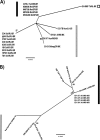Frequency and genetic diversity of the MAT1 locus of Histoplasma capsulatum isolates in Mexico and Brazil
- PMID: 23709181
- PMCID: PMC3697462
- DOI: 10.1128/EC.00012-13
Frequency and genetic diversity of the MAT1 locus of Histoplasma capsulatum isolates in Mexico and Brazil
Abstract
The MAT1-1 and MAT1-2 idiomorphs associated with the MAT1 locus of Histoplasma capsulatum were identified by PCR. A total of 28 fungal isolates, 6 isolates from human clinical samples and 22 isolates from environmental (infected bat and contaminated soil) samples, were studied. Among the 14 isolates from Mexico, 71.4% (95% confidence interval [95% CI], 48.3% to 94.5%) were of the MAT1-2 genotype, whereas 100% of the isolates from Brazil were of the MAT1-1 genotype. Each MAT1 idiomorphic region was sequenced and aligned, using the sequences of the G-217B (+ mating type) and G-186AR (- mating type) strains as references. BLASTn analyses of the MAT1-1 and MAT1-2 sequences studied correlated with their respective + and - mating type genotypes. Trees were generated by the maximum likelihood (ML) method to search for similarity among isolates of each MAT1 idiomorph. All MAT1-1 isolates originated from Brazilian bats formed a well-defined group; three isolates from Mexico, the G-217B strain, and a subgroup encompassing all soil-derived isolates and two clinical isolates from Brazil formed a second group; last, one isolate (EH-696P) from a migratory bat captured in Mexico formed a third group of the MAT1-1 genotype. The MAT1-2 idiomorph formed two groups, one of which included two H. capsulatum isolates from infected bats that were closely related to the G-186AR strain. The other group was formed by two human isolates and six isolates from infected bats. Concatenated ML trees, with internal transcribed spacer 1 (ITS1) -5.8S-ITS2 and MAT1-1 or MAT1-2 sequences, support the relatedness of MAT1-1 or MAT1-2 isolates. H. capsulatum mating types were associated with the geographical origin of the isolates, and all isolates from Brazil correlated with their environmental sources.
Figures


References
-
- Kwon-Chung KJ. 1972. Sexual stage of Histoplasma capsulatum. Science 175: 326. - PubMed
-
- Kwon-Chung KJ. 1972. Emmonsiella capsulata: perfect state of Histoplasma capsulatum. Science 177:368– 369 - PubMed
-
- Kwon-Chung KJ. 1973. Studies on Emmonsiella capsulata. I. Heterothallism and development of the ascocarp. Mycologia 65: 109– 121 - PubMed
-
- Kwon-Chung KJ, Bennett JE. 1992. Medical mycology. Lea and Febiger, Philadelphia, PA
-
- Kwon-Chung KJ, Weeks RJ, Larsh HW. 1974. Studies on Emmonsiella capsulata (Histoplasma capsulatum). II. Distribution of the two mating types in 13 endemic states of the United States. Am. J. Epidemiol. 99: 44– 49 - PubMed
Publication types
MeSH terms
Substances
Associated data
- Actions
- Actions
- Actions
- Actions
- Actions
- Actions
- Actions
- Actions
- Actions
- Actions
- Actions
- Actions
- Actions
- Actions
- Actions
- Actions
- Actions
- Actions
- Actions
- Actions
- Actions
- Actions
- Actions
- Actions
- Actions
- Actions
- Actions
- Actions
LinkOut - more resources
Full Text Sources
Other Literature Sources

